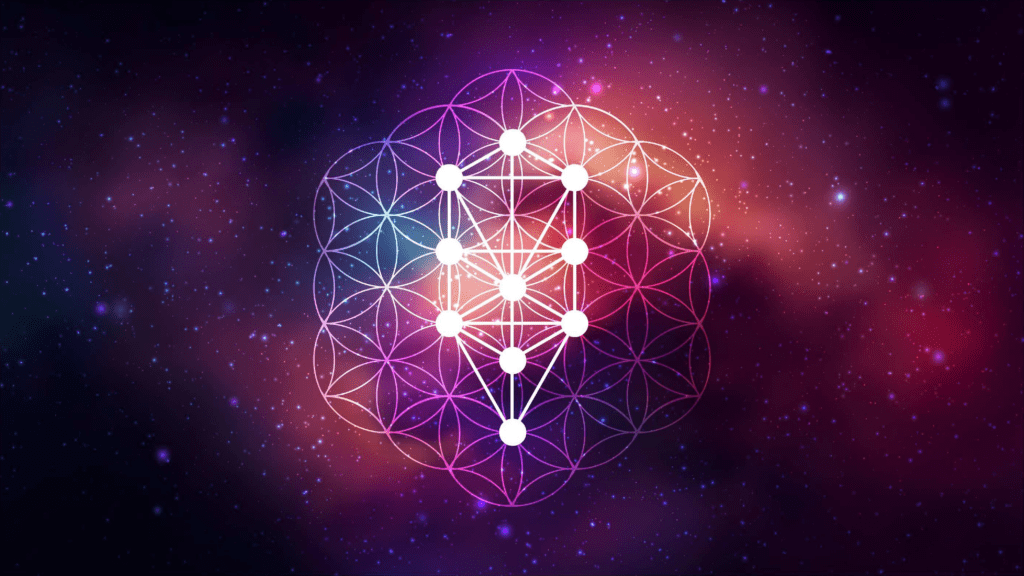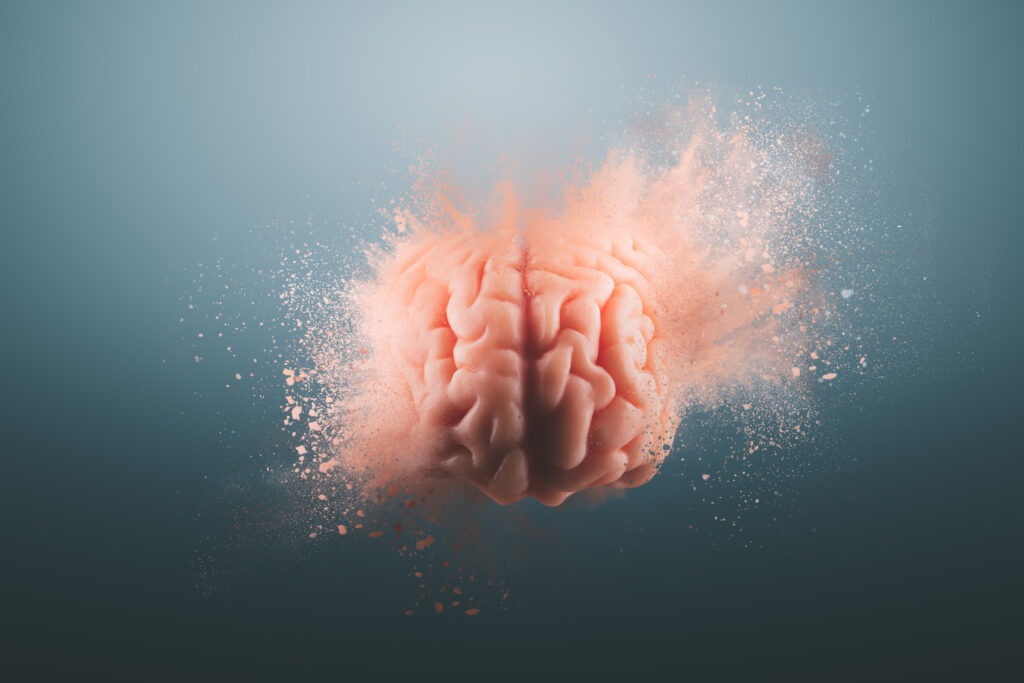There is no self: the periodic table of experience
Reading | Theology
![]() Asher Walden, PhD | 2021-07-25
Asher Walden, PhD | 2021-07-25

Theologian Dr. Asher Walden argues that the self can be accounted for purely as a momentary aggregate of mental factors, without any need to appeal to some additional thing that stands outside the mind-stream. Although we normally think of experience as some kind of relation between two independent real things—a subject and an object—he argues that, in truth, there is just experience; experience is the real thing.
When introducing a discussion on the nature of consciousness, philosophers typically begin with this sort of comment: “As I sit at my desk, I am aware of the sound of voices chatting cheerfully across the room. It is like the babbling of the ocean on a peaceful summer day. Also, I become aware that I am aware of that sound. This is a common enough event—it is usually called self-consciousness, or reflexive awareness, or something similar.”
This all seems innocuous enough. Not the kind of point which, by itself, would seem to start an argument. I suppose they are (unconsciously?) following the precedent set by Descartes in his Meditations. And yet it is viciously misleading. Despite the excellent and important work that has been done in developing and exploring the mind-only doctrine, we still carry along some old assumptions about what consciousness is and how it works which could not possibly be true. One of these is the assumption that the human person, or even the human brain, is the basic unit or locus of consciousness. This gives rise to a number of problems from the standpoint of technical academic philosophy. But it is also the foundation of what I think gives people such a hard time even considering idealism* as a real possibility. My guess is, when people reject idealism out of hand, it has to do with the feeling that consciousness is essentially something individual humans have or do. This is almost a grammatical or linguistic point: what we should be saying is that consciousness is something we participate in or share.
If you want a clearer and more typical example of what consciousness is, pick one of these: sharing a joke with friends; playing music together; locking gazes however briefly with an attractive stranger; playing chess or team sports; even watching a movie or play in a theatre, surrounded by strangers. If you like evolutionary modes of thinking, treat consciousness (especially higher-order consciousness) as a way of coordinating purposes or intentions across organisms. Is there such a thing as truly private, isolated awareness? Possibly, in defective or pathological cases. But even as I write this, sitting alone at my desk (overhearing those cheerful human voices), I am in implicit conversation with a community of scholars who share with me a set of ideas, interpretations, and values. You and I share a thought-sphere which is not localized in space or time. Hello, my friends. Nice to be here with you.
In order to get behind this illusion of isolated consciousness, I would like to discuss an alternate form of analysis based on the Buddhist text tradition called Abhidharma. Now, anyone interested in the philosophy of idealism should be at least familiar with the availability of resources in Buddhist philosophy. Buddhists were, so to speak, first on the scene with respect to the relevant insights. And they have developed over the course of millennia some powerful tools and strategies around the analysis of mind, language, truth, and metaphysics. In the last generation, there has been a powerful resurgence of interest in these approaches among Western-trained analytic philosophers. Here, I want to focus on just one: the idea that the whole world can be described in terms of individual ‘units’ of consciousness, called dharmas.
What are the dharmas? They are sort of the phenomenological equivalent of the periodic table of elements. The idea is that any manifestation of consciousness can be understood as some combination of discrete, indivisible mental factors. And since the whole world is understood to be consciousness only, the discrete modes of consciousness are also—modes of being. Like the atomic elements of physics, these mental factors can be organized into functional groups for heuristic and pedagogical purposes. Over the centuries, a number of lists of the Dharmas have been compiled, usually comprising around 50 to 100 mental factors. Generally, the strategy is to come up with the smallest list possible that accounts for all aspects of consciousness, including the various forms of higher-order, reflective consciousness and meta-cognition. Thus, the basic units of consciousness are these mental factors, not persons. From the Buddhist standpoint, the subjective self is not an ultimate or really existing ‘thing.’ It is simply, if you like, a localized cluster of momentary factors. The factors are enough to explain why we experience ourselves as selves, discrete and enduring in time, even though being a self is more akin to a wave or eddy in the ocean of consciousness.
Likewise, what we call consciousness is not just one thing, or place, or container, within which various kinds of content occur. Instead, we should understand it as a tightly interwoven bundle of different conscious elements. What are those elements? They include sense-factors, more or less wholesome desires, what we call moral or personality factors, and so on. The list is quite heterogenous and not at all easy to organize in a clear logical schematic. Many of the factors appear ‘simple’ or atomic (colors and other elements of vision; hot and cold; pain, itch and tickle, etc.). Others may seem higher order, even constructed, such as the way the mind synthesizes discrete objects, and moral perceptions such as shame. Thus, mental factors are modular in some cases and to some extent, but in other cases hierarchical. A given factor may simultaneously act independently and also as a subcomponent for one or more other factors. The traditional methodology for developing the list, the sub-categories, and the typical interactions between elements, involved both contemplative introspection and interpretation of the Buddhist scriptures. Nowadays, we can add another set of powerful tools from the neurosciences.
To summarize briefly, the list we would generate today would look something like this:
- The four external senses (sight, sound, smell, taste).
- The four internal/projective senses (touch, proprioception, balance, and visceral interoception).
- The various perceptual ‘parts’ of those senses, if they have parts. For instance, taste has five parts (sweet, sour, etc.), balance has three parts (up/down, forward/back, left/right), smell has no parts. Interoception doesn’t quite have parts—it may be better to think of it as its own category, comprising hunger, thirst, sexual desire, and so on.
- A number of specialized modules that build upon the foregoing factors. They include the perception of language, number, human faces, intention, time, and perhaps a few others.
- The factors of judgment (personality dimensions, moral intuitions).
- Three overarching forms of synthesis: the synthesis of self, which neuroscientists describe as the ‘body schema’; the synthesis of world, conjoining the four external senses in the context of number, time, and the other specialized modules; and the synthesis of judgment, which combines our various desires and judgment factors to produce our sense of freely determined will.
- The traditional lists of Abhidharma also include one ‘unconditioned’ element: nirvana. I see no reason not to include it here, though we may want to quibble about the proper name for it. It could be called nothingness or emptiness in English, but I actually prefer to call it Kenosis,** both as a way to invite conversation with the Christian mystical traditions, and also because Kenosis has the sense of an activity or process, rather than a state: ‘Emptying’ (Perhaps in German, it would be called ‘Dasein’).
This list is not final: it is an ongoing and still-shifting product of empirical research and interpretation. Generally speaking, the purpose of this kind of list is to understand the structure of phenomenal experience. In the Buddhist framework, suffering is caused by an ignorance of the true nature of the self and the world, and attachment to a certain misconstrual of the same. Abhidharma is the attempt to explain both the true nature of experience, and the reasons why we come to the incorrect conclusions that we typically do. We believe that we are selves, and that our experience is something that happens in and for that self. The Buddhist (and Idealist) reply is that experience is all there is.
No one would be surprised if, looking out the same window, he consistently saw the same things, day in and day out. Or if, working in the same office, she had the same experience of job-satisfaction. Just so, the sum of subjective experience is very consistent over time simply because the modes of consciousness are taking place in the same location, namely our body. Indeed, many of the modes of consciousness we enjoy not only are structured from the perspective of the body (vision, orientation in space) but are really about bodily states (hunger, pain, proprioception). Of course, perception of self takes place within the synthesis of physiological modes (the body schema) and also, perhaps more importantly, social modes of consciousness. Much of what we call self-consciousness is really the awareness of our rank or status in relation to the other people we regularly encounter, resulting in a pattern of awareness commonly referred to as ‘self-esteem.’ This is one of the nine modes of judgment mentioned above. There is also the unconditioned element of nirvana, which is a kind of background hum which, here as elsewhere, we misconstrue as something private and internal. This mental factor is, I suspect, the one that gives rise to the irreducible suchness of the first-person perspective, which many people think cognitive science will simply never be able to ‘explain.’ The point is that the self can be exhaustively accounted for as a momentary aggregate of mental factors, without any need to appeal to some additional thing that stands outside the mind-stream.
Similarly, we believe that our perceptual experience is about independently existing external objects. But the Buddhists have a host of skeptical arguments against this notion (I won’t try to summarize those arguments here). Instead, the physical objects we perceive have no depth nature, essence or glue to play the role of cause or source or substrate of those cognizable qualities that are the content of our awareness of them. Things are just functional unities of qualities: both the qualities we are able to perceive directly, and any other qualities which we do not. This does not mean, or require, that at any given time some sentient being is or must be in the act of actually perceiving them. It just means that everything there is to know or say about a thing is the sort of thing that can be, as we normally say, within consciousness.
The overall upshot of the deconstruction of the independent self and the complementary deconstruction of enduring objects is a ‘flipped’ understanding of experience. We normally think of experience as some kind of relation between two independent real things: a subject and an object. But the truth is that there is just experience—experience is the real thing. It just happens to be the case that experience has this bipolar structure for us, constrained and extended between the synthesis of self and the synthesis of world, with the synthesis of judgment determining our actions and reactions from the one toward the other. These things are mental factors, factors of consciousness. In other words, they are qualities or dimensions of consciousness, misconstrued as the foundation of consciousness itself. Consciousness has no foundation. It is the foundation.
Finally, the Abhidharmic analysis of consciousness in terms of dharmas or mental factors paves the way for an understanding of consciousness as something that is intrinsically shared, public. The perception of a color or a note is not something internal and private at all. It is a reality that any of us who are looking at the same thing or listening to the same music can share in. Just as we normally think of physical bodies standing near to one another, in the same room, we should think of ourselves as occupying or participating in the same consciousness, in phenomenal proximity to one another. A person experiences similar (though not identical) things over time: what this really means is that, at two points in time, the content of experience is represented by two largely overlapping sets of dharmas. Just so, two people, at the same time, in the same place, are constituted by two overlapping sets of dharmas. The closer they are in space and in mutual understanding, the greater the overlap in dharmas will be. This point must be emphasized as much as possible: it is not that they have different experiences of the same things; rather, it is the same experience happening along two different vectors, as if a tree had two branches that diverged and then grew back together, or like a steam that divides around an island and then rejoins itself.
Philosophy and religion share, at their core, the problem of living together. How do we do it? What are the costs? What, impossibly, would the alternative be? Religion gives us the forms; the rituals and institutions and creeds, by which humans harmonize their experience, values and goals. Philosophy is reflection on the preconditions for the possibility that such forms are successful. Living together—this is all that matters.
What they call solipsism represents a real and legitimate fear, for creatures such as ourselves. Much of the time, communication and cooperation are so smooth and seamless that we take it for granted that we share a common ground, common experience. But when things break down, in families and in politics, the walls go up, and the community splinters. Then we wonder: how could those others possibly know how we feel? How could they possibly be so misguided? Do they even live in the same world as us? And sometimes, the problem is not with them, but with me: why is it so hard to reach out? Why don’t I feel included? Am I really as alone as I seem to be? When philosophers ask about how we gain knowledge of the world, they are implicitly asking about something we do together. They are asking how we all end up with the same knowledge, about the same world. How is such knowledge possible? How do I know that what I experience is not a kind of hallucination?
The philosophy of idealism addresses these questions by defending, in the most consistent and tenacious way, the reality of common experience. Rather than individual beings, with more or less similar experiences, the world is constituted by common experience, structured in the shape of more or less overlapping and interdependent selves.
* Editor’s note: Idealism is the notion that all nature is mental in essence.
** Editor’s note: kenosis means an emptying out of one’s own individual self and will.
Selected References:
Baron-Cohen, Simon. Mindblindness: An essay on autism and theory of mind. The MIT Press, 1995.
Bodhi, Bhikkhu, ed., Mahathera Narada, trans. & ed. A Comprehensive Manual of Abhidhamma: the Abhidammatha sangaha of Acariya Anuruddha. Buddhist Publication Society, 1993.
Chan, Wing-Tsit, ed. and trans. A Sourcebook in Chinese Philosophy. Princeton University Press, 1969.
Chadha, Monima. No-Self and the phenomenology of agency. Phenom Cogn Sci 16, 187–205 (2017).
Cook, Francis K., trans. Three texts on Consciousness Only. BDK America, 2006.
Garfield, Jay. Empty Words: Buddhist philosophy and cross-cultural interpretation. Oxford University Press, 2002.
Haidt, Jonathan. The Righteous Mind: Why good people are divided by politics and religion. Vintage Books, 2012.
Nettle, Daniel. Personality: What makes you the way you are. Oxford University Press, 2007.
Nyanaponika Thera. Bhikkhu Bodhi, ed. Abhidhamma Studies: Buddhist Explorations of Consciousness and Time. Wisdom Publications, 2010.
Pinker, Steven. How the Mind Works. W.W. Norton & Co., 1999.
Siderits, Mark, Evan Thompson, and Dan Zahavi, eds. Self, no self?: Perspectives from analytical, phenomenological, and Indian traditions. Oxford University Press, 2011.
Wittgenstein, Ludwig. Philosophical Investigations. G.E.M. Anscombe, trans. Wiley-Blackwell, 1973.
Wood, Thomas E. Mind Only: A philosophical and doctrinal analysis of the Vijnanavada. University of Hawaii Press, 1991.

Essentia Foundation communicates, in an accessible but rigorous manner, the latest results in science and philosophy that point to the mental nature of reality. We are committed to strict, academic-level curation of the material we publish.
Recently published
Reading
Essays
Seeing
Videos
Let us build the future of our culture together
Essentia Foundation is a registered non-profit committed to making its content as accessible as possible and without advertisements. Therefore, we depend on contributions from people like you to continue to do our work. There are many ways to contribute.















